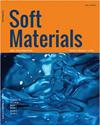纤维增强双晶凸介质弹性体的电热力学不稳定性研究
IF 1.4
4区 材料科学
Q4 MATERIALS SCIENCE, MULTIDISCIPLINARY
引用次数: 0
摘要
摘要:基于智能电活性聚合物的介电弹性体致动器(DEAs)能够实现几何定向。这些致动器由于能够在各种应力和温度下通电而容易受到电-热-机械不稳定性的影响。这项工作为研究电-热-机械耦合各向异性双晶凸DEAs的不稳定性提供了数学推导。平衡方程是在假定由于凸结构引起的锥度比和由于各向异性引起的铺层角度的情况下公式化的。MATLAB用于数值求解各种机械、电气和热负载下的临界拉伸、标称电场和熵的复杂方程。观察结果表明,在和的条件下,从到的标称应力增加会导致标称电场的峰值相应增加,特别是轴向拉伸值分别为2.107和2.159时,从到。当相对于标称电位移报告标称电场时,它随着温度的升高而增强,并且随着标称应力和锥度比的升高而减小。当纤维平行于轴向拉伸方向排列时,与垂直方向的拉伸失效点相比,拉伸失效点最小。本研究表明,升高的温度和标称应力会导致熵的增加,从而导致系统无序度的相应增加。此外,发现纤维相对于轴向拉伸的垂直排列可以降低系统的随机性程度。本文章由计算机程序翻译,如有差异,请以英文原文为准。
Electro-thermo-mechanical instability study of fiber-reinforced bimorph convex dielectric elastomer
ABSTRACT Intelligent electroactive polymer-based dielectric elastomer actuators (DEAs) are capable of geometrical disorientation. These actuators are susceptible to electro-thermo-mechanical instability due to their ability to be electrically powered at various stresses and temperatures. This proposed work provides mathematical derivations for the study of instability in coupled electro-thermo-mechanical anisotropic bimorph convex DEAs. The equilibrium equations are formulated assuming the taper ratio because of the convex structure and the ply angles due to anisotropy. MATLAB is employed to numerically solve the complicated equations for critical stretch, nominal electric field, and entropy under a variety of mechanical, electrical, and thermal loads. The observations indicate that under conditions of , and , an increase in nominal stress from to leads to a corresponding increase in the peak point of the nominal electric field, specifically from to for axial stretch values of 2.107 and 2.159, respectively. When the nominal electric field is reported against nominal electric displacement, it enhances with the rise in temperature and reduces with the hike in nominal stress and taper ratio. When the fibers are arranged parallel to the axial stretch direction then the failure point of stretch is least, compared to that oriented in a perpendicular direction. The present study demonstrates that elevated temperature and nominal stress result in an increase in entropy, leading to a corresponding increase in system disorder. Furthermore, the perpendicular alignment of fibers with respect to axial stretch is found to decrease the degree of system randomness.
求助全文
通过发布文献求助,成功后即可免费获取论文全文。
去求助
来源期刊

Soft Materials
工程技术-材料科学:综合
CiteScore
2.90
自引率
0.00%
发文量
21
审稿时长
2.2 months
期刊介绍:
Providing a common forum for all soft matter scientists, Soft Materials covers theory, simulation, and experimental research in this rapidly expanding and interdisciplinary field. As soft materials are often at the heart of modern technologies, soft matter science has implications and applications in many areas ranging from biology to engineering.
Unlike many journals which focus primarily on individual classes of materials or particular applications, Soft Materials draw on all physical, chemical, materials science, and biological aspects of soft matter. Featured topics include polymers, biomacromolecules, colloids, membranes, Langmuir-Blodgett films, liquid crystals, granular matter, soft interfaces, complex fluids, surfactants, gels, nanomaterials, self-organization, supramolecular science, molecular recognition, soft glasses, amphiphiles, foams, and active matter.
Truly international in scope, Soft Materials contains original research, invited reviews, in-depth technical tutorials, and book reviews.
 求助内容:
求助内容: 应助结果提醒方式:
应助结果提醒方式:


